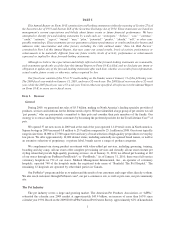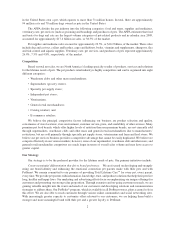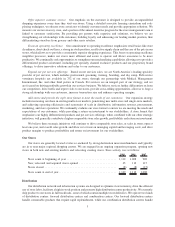Petsmart 2009 Annual Report Download - page 16
Download and view the complete annual report
Please find page 16 of the 2009 Petsmart annual report below. You can navigate through the pages in the report by either clicking on the pages listed below, or by using the keyword search tool below to find specific information within the annual report.Neil H. Stacey was appointed Senior Vice President of Human Resources in February 2009. He joined
PetSmart in 1995 and served in a number of leadership roles including Vice President General Merchandise
Manager from 1995 to 1999, Senior Vice President of Merchandising Consumables from 1999 to 2000, Regional
Vice President from 2000 to 2007, and Divisional Vice President of Operations from 2007 to 2009. Prior to joining
PetSmart, he was employed at American Stores, a national food and drug retailer, where he held several leadership
positions including Vice President of Advertising and Market Development, Vice President of Merchandising and
Vice President of Business Process Redesign.
Bruce K. Thorn was appointed Senior Vice President, Supply Chain in December 2009. He joined PetSmart in
2007 as Vice President, Supply Chain Solutions, and served as Vice President, Supply Chain from 2008 to 2009.
Prior to joining PetSmart, he served as Chief Operating Officer for LESCO, Inc., a public company and leader in the
professional turf care industry. He previously held leadership roles with Gap, Inc., Cintas Corporation and the
United States Army.
Item 1A. Risk Factors
In the normal course of business, our operations, financial condition and results of operations are routinely
subjected to a variety of risks. Our actual financial results could differ materially from projected results due to some
or all of the factors discussed below. You should carefully consider the risks and uncertainties described below, as
well as those discussed in the “Competition,” “Our Stores,” “Distribution” and “Government Regulation” sections
of this Annual Report on Form 10-K. In addition, the current global economic conditions amplify many of these
risks.
A decline in consumer spending or a change in consumer preferences could reduce our sales or profitability
and harm our business.
Our sales depend on consumer spending, which is influenced by factors beyond our control, including general
economic conditions, the availability of discretionary income and credit, weather, consumer confidence and unem-
ployment levels. We may experience declines in sales or changes in the types of products sold during economic
downturns. Any material decline in the amount of consumer spending could reduce our sales, and a decrease in the sales
of higher-margin products could reduce profitability, and, in each case, harm our business. The success of our business
depends in part on our ability to identify and respond to evolving trends in demographics and consumer preferences.
Failure to timely identify or effectively respond to changing consumer tastes, preferences, spending patterns and pet care
needs could adversely affect our relationship with our customers, the demand for our products and services, our market
share and our profitability.
The pet products and services retail industry is very competitive and continued competitive forces may
adversely impact our business and financial results.
The pet products and services retail industry is very competitive. We compete with supermarkets, warehouse clubs
and other mass and general retail merchandisers, many of which are larger and have significantly greater resources than
we have. We also compete with a number of specialty pet supply stores and independent pet stores, veterinarians, catalog
retailers and e-commerce retailers. The pet products and services retail industry has become increasingly competitive due
to the expansion of pet-related product offerings by certain supermarkets, warehouse clubs and other mass and retail
merchandisers and the entrance of other specialty retailers into the pet food and pet supply market, some of which have
developed store formats similar to ours. We can make no assurances we will not face greater competition from these or
other retailers in the future. In particular, if supermarket, warehouse club or other mass and retail merchandiser
competitors seek to gain or retain market share by reducing prices, we would likely reduce our prices on similar product
offerings in order to remain competitive, which may result in a decrease in our market share, sales, operating results and
profitability and require a change in our operating strategies.
8
























